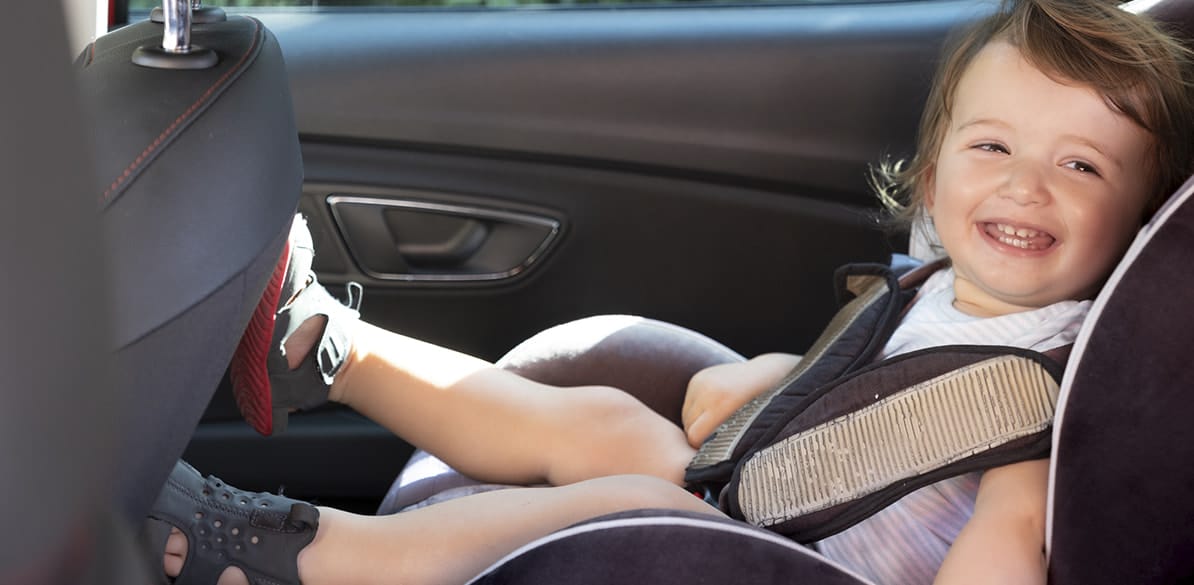Survival space
The proper use of child restraint systems makes all the difference

Road Safety
What we do when installing the child and the child seat will determine the survival space necessary to reduce the child’s injuries, and to ensure that the child is unharmed in an accident.
In the event of sudden deceleration or collision, the child’s position will shift, with various movements and stages of impact coming into play.
First, the car brakes sharply. In that phase, the child seat tries to continue to move forward, according to Newton’s first law, and will do so until it encounters resistance, according to Newton’s second law. This resistance will develop quickly if the car seat is anchored with an ISOFIX+ ANTI-ROTATION SYSTEM, or more slowly if the car seat is restrained using the seat belt. Until the belt has sufficient tension it will not begin to restrain the seat. The seat will therefore move forward. We call this the first impact.
Once the seat has begun to slow down, the child will then continue to move forwards until the harness becomes sufficiently taut to slow it down. We call this the second impact. There is a third impact, which results from the child’s organs hitting its skeleton, but we will not talk about this one today.
Let’s focus on the first impact. Choosing a seat with ISOFIX and an anti-rotational system decreases the possibility of any seat installation errors, while also greatly reducing the first impact, since there is a practically rigid connection between the car and the seat. When the car brakes sharply, because of this rigid connection, the child seat also stops quickly. For this reason, the choice of car seat clearly affects the survival space. We will prioritize car seats with ISOFIX anchor points. The seat must also be pressed firmly against the backrest to ensure that the head is as far back as possible.
Now let’s look at the second impact. When a chair has a harness, the tautness of the harness determines how much survival space we need, so we must tighten the harness as much as possible without causing any discomfort to the child. The height of the headrest is also important, as most chairs position the shoulder height of the harness with the headrest, and we should always place the headrest so that the height of the harness is at the same level as the shoulder, to ensure the best retention.
If the child is strapped into the car, we must ensure that the belt has no slack, tightening it once the child is in. Above all pay attention to the last step, which we will now explain.
The final, but really important, step has to do neither with the seat nor with the child. In the event of a collision, the first impact and the second impact will cause the child’s head to move forward in a circular motion. We have to make sure that during that movement they DO NOT HIT ANYTHING. We must therefore place the backrest of the front seat as far away as possible from the child’s head. If there is no passenger in the front seat, we should pull the front seat as far forward as possible, with the backrest as vertical as possible. If there is a front passenger, they should adjust the seat as far forwards as possible without affecting their comfort.
Finally, it should be noted that the survival space is most important for forward-facing seats, as in these there is a risk of impact with the front seat, which must be avoided at all costs. In the case of rear-facing seats, it is the child seat that would hit the front seat, which drastically reduces the risk of injury.
In summary, we must keep several basic ideas in mind:
- Use rear-facing car seats as long as possible.
- When the car seat is forward-facing, prioritize the use of ISOFIX car seats.
- Tighten the harness and seat belt properly.
- Move the front seat as far forward as you can, making the backrest as vertical as possible.
